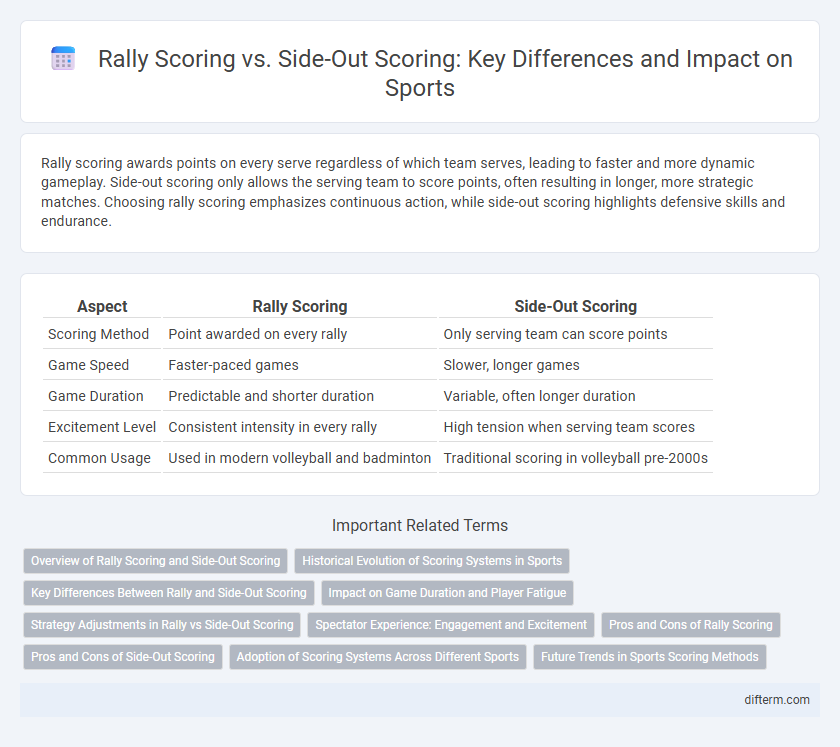Rally scoring awards points on every serve regardless of which team serves, leading to faster and more dynamic gameplay. Side-out scoring only allows the serving team to score points, often resulting in longer, more strategic matches. Choosing rally scoring emphasizes continuous action, while side-out scoring highlights defensive skills and endurance.
Table of Comparison
| Aspect | Rally Scoring | Side-Out Scoring |
|---|---|---|
| Scoring Method | Point awarded on every rally | Only serving team can score points |
| Game Speed | Faster-paced games | Slower, longer games |
| Game Duration | Predictable and shorter duration | Variable, often longer duration |
| Excitement Level | Consistent intensity in every rally | High tension when serving team scores |
| Common Usage | Used in modern volleyball and badminton | Traditional scoring in volleyball pre-2000s |
Overview of Rally Scoring and Side-Out Scoring
Rally scoring awards a point on every rally, regardless of which team serves, speeding up game pace and increasing scoring opportunities. Side-out scoring grants points only to the serving team when they win a rally, often resulting in longer matches with strategic service plays. Both systems significantly impact game dynamics, strategies, and match duration in sports like volleyball.
Historical Evolution of Scoring Systems in Sports
Rally scoring and side-out scoring represent significant milestones in the historical evolution of scoring systems in sports, with rally scoring becoming the dominant format due to its efficiency in volleyball and badminton since the late 20th century. Side-out scoring, originally the standard in volleyball, required the serving team to win a rally to score a point, often prolonging matches and reducing spectator appeal. The shift towards rally scoring standardized point accumulation on every rally regardless of serve, enhancing game pace and viewer engagement, reflecting broader trends in sports toward faster, more dynamic scoring methods.
Key Differences Between Rally and Side-Out Scoring
Rally scoring awards points on every rally regardless of which team served, resulting in faster-paced games and consistent scoring opportunities. Side-out scoring only grants points to the serving team, often extending match duration due to the necessity of winning the serve to score. The differences impact strategy, with rally scoring demanding aggressive play to capitalize on every rally, while side-out encourages defensive focus to regain service and score.
Impact on Game Duration and Player Fatigue
Rally scoring accelerates game duration by awarding points on every rally, reducing total rally counts and minimizing extended playtime compared to side-out scoring, where points are only scored on serve possession. This compression of match length directly decreases player fatigue by limiting prolonged exertion in extended matches typical of side-out scoring. Consequently, rally scoring enhances endurance management and allows for more predictable scheduling in sports like volleyball.
Strategy Adjustments in Rally vs Side-Out Scoring
Rally scoring demands aggressive and consistent serving strategies to capitalize on every point opportunity, while side-out scoring allows teams to focus more on defensive plays and regaining serve control. Players in rally scoring must minimize unforced errors due to the continuous point awarding system, prompting adjustments in shot selection and risk management. In contrast, side-out scoring emphasizes patience and strategic waits for service breaks, influencing teams to prioritize stamina and mental resilience during extended rallies.
Spectator Experience: Engagement and Excitement
Rally scoring enhances spectator engagement by providing continuous point opportunities, resulting in faster-paced matches and sustained excitement. Unlike side-out scoring, where only the serving team can earn points, rally scoring maintains consistent action that keeps audiences invested throughout each rally. This scoring system amplifies the intensity and unpredictability of the game, creating a more thrilling experience for fans.
Pros and Cons of Rally Scoring
Rally scoring accelerates the pace of volleyball by awarding points on every rally, reducing match duration and increasing spectator engagement. However, this system can favor stronger teams by limiting opportunities for underdogs to mount comebacks, potentially decreasing competitive balance. Despite its faster gameplay, rally scoring may also intensify pressure on players during each serve, affecting performance consistency.
Pros and Cons of Side-Out Scoring
Side-out scoring in volleyball awards points exclusively to the serving team, which can prolong matches and increase the strategic importance of serving and defense. This system emphasizes player endurance and mental toughness but may lead to slower-paced games and less frequent scoring excitement. While side-out scoring enhances competitive balance by requiring service breaks to earn points, it can frustrate casual viewers accustomed to the rapid point accumulation found in rally scoring.
Adoption of Scoring Systems Across Different Sports
Rally scoring has been widely adopted in sports like volleyball and badminton due to its ability to speed up gameplay and maintain continuous action, contrasting with the traditional side-out scoring system that prolonged matches by requiring the serving team to win a point. Volleyball officially transitioned to rally scoring in the late 1990s, enhancing spectator engagement and television broadcasting appeal. Meanwhile, some sports such as pickleball and traditional handball retain side-out scoring, valuing the strategic complexity it offers despite longer match durations.
Future Trends in Sports Scoring Methods
Future trends in sports scoring methods highlight a gradual shift from traditional side-out scoring to rally scoring due to its faster pace and increased spectator engagement. Innovations in technology enable real-time analytics and automated refereeing, enhancing accuracy and transparency in scoring systems. Emphasis on digital integration and audience interactivity will further transform how scoring data drives game strategies and fan experiences.
rally scoring vs side-out scoring Infographic

 difterm.com
difterm.com